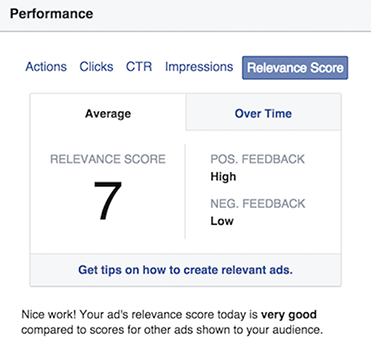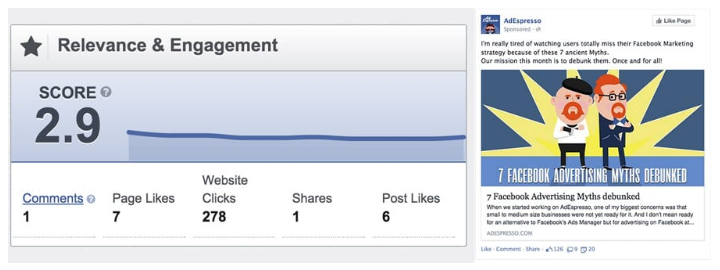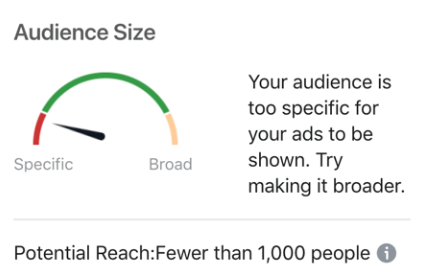It’s neither enjoyable, nor profitable, to run a campaign that doesn’t resonate with your audience, which is why every top online ad platform has a metric for measuring ad quality and relevance. For Google Ads, one metric is Quality Score. For Facebook, it’s relevance score.
Today we’ll dissect Facebook relevance score — addressing what it is, how it’s calculated, what is a good score on Facebook, and how to increase the score for maximum results.
Update: Beginning April 30, 2019 Facebook is replacing the relevance score metric with three new dimensions: quality ranking, engagement rate ranking, and conversion rate ranking. Also included in the changes is how Facebook calculates potential reach because now they are only including people in the potential reach data who were shown an ad on Facebook in the previous 30 days. More on the changes in the official announcement here.
What is the Facebook relevance score?
Relevance score combines various ad quality and relevance factors to give advertisers an idea of how pertinent their ads are to a target audience, compared to competitors. Scores range from 1-10, with 1 being least relevant than other ads targeting the same audience, and 10 being highly relevant:

Advertisers can see their Facebook ad relevance score once their ad has reached 500 impressions.
Why Facebook relevance score matters
Similar to Google’s Quality Score, having a higher relevance score can lower your CPC on Facebook.
Facebook’s ad delivery system is designed to show the right content to the right people, and a high score is seen by the system as a positive signal. When multiple advertisers are trying to reach overlapping audiences, the one with the highest bid and the most relevant ads wins.
Therefore, if you bid the same as (or more than) a competitor — as long as your relevance score is higher — your ads are more likely to show to the shared target audience.
Looking at the data
To demonstrate the importance of relevance scores, AdEspresso analyzed over 104,256 ads to measure how scores can affect CPC. Here’s what they found…
This ad had a relevance score of 2.9 and poor targeting, and it cost them an average of $0.14 per website click:

This is the same exact ad, but targeted to a custom audience of users who visited the website in the last 90 days. The relevance score here was 8, which lead to a CPC of only $0.03:

With the same budget, AdEspresso generated 4x more clicks (1,103 vs. 278), with more shares, likes, and Page likes as well.
The data was clear according to Facebook Ads Specialist, Paul Fairbrother:
The higher the relevance score is, the lower the cost per click is and the better the click-through rate.
How is Facebook ad relevance score calculated?
Ads are scored between 1 and 10, with 10 being the highest. Scores are calculated based on the expected positive and negative engagement an ad will receive from its target audience. The more positive anticipated interactions, the higher the relevance score.
Note: It’s based on “expected” engagement, because Facebook doesn’t use actual feedback such as likes, shares, comments, etc. Instead, it calculates an audience’s anticipated response to an ad using the campaign goal and audience granularity to determine the likelihood of the desired action being taken, or negative feedback being provided.
Positive feedback is a subjective term depending on the ad’s objective, but may include:
- Video views
- App installs
- Link clicks
Negative feedback includes:
- Hiding the ad
- Reporting the ad

If your ad is relevant to your target audience, more people will take your desired action (positive feedback) and fewer people will hide or flag your ads (negative feedback). In turn, this will increase your relevance score and lower your CPC.
What is a good relevance score on Facebook ads?
A relevance score of 1 is the worst. It means that your ad barely pertains to your audience, and for Facebook to continue serving it, you must pay a premium.
Conversely, a relevance score between 7-10 indicates an above-average score, and increases the likelihood of your ad being served.
Of course, the ideal relevance store is a 10/10, but this isn’t very common. It is attainable, though, which means advertisers should strive to score a 10 by split testing and optimizing their ads. So how can digital advertisers increase their score?
How to increase Facebook relevance score
1. Rethink your targeting strategy
This is tricky because there’s a fine line between targeting too much and not enough.
On one hand, you should refine your audience targeting enough to ensure a high degree of commonality among each member so you can create ads and offers that speak directly to their needs. If targeting is too broad, you run the risk of serving ads to users who aren’t receptive to your message:

On the other hand, many advertisers refine their target audience too much, and that can also negatively affect ad performance and relevance score:

One option is to launch an ad with broad targeting and let Facebook run its learning phase. During the learning phase, Facebook works to discover which users within your target audience are most likely to take your desired action. So by starting with a larger target audience, there’s more scope to find high-converting segments within it.
2. Shorten retargeting windows
Retargeting on Facebook can be incredibly effective, as some of the highest ROAS numbers often come from retargeting campaigns.
Facebook allows advertisers to target users who have visited their website within the last 180 days,which is the retargeting window most advertisers use. However, this is a long time to see a repeat ad from the same company, and ad fatigue can negatively impact relevance score.
You can achieve better results by shortening retargeting windows to 30-day or even 14-day campaigns:

3. Know your target audience to better tailor your ads
Targeting the right audience is only half the work, though. You also have to craft a message that can speak directly to them because great creative and copy that connects with your target audience will drive engagement and improve your score.
Some basic tips to keep in mind:
- Make your ads look as close to regular Facebook posts as possible to avoid turning off prospects and generating high levels of negative feedback.
- Publish videos with high-quality lighting and audio, and omit the headline and CTA button since these clearly mark your content as an ad
- Create image ads with no more than 20% text, and that videos should be created with high-quality lighting and audio.
4. Use multiple ad variations
It’s important to simultaneously run a variety of different ads to the same target audience to avoid ad frequency climbing too high. Ad frequency refers to the average number of times someone within your target audience has seen your ad. If too high, your target audience may become bored with your ads, negative feedback may increase, and your relevance score will may decrease.
(What constitutes “too high” depends primarily on whether you’re targeting a warm or cold audience because warm audiences will generally tolerate higher frequency numbers than cold audiences.)
Especially when targeting a relatively small audience, varying your ad creative helps keep things fresh, prevents ad fatigue, maintains higher relevance scores.
This also allows you to analyze your relevance score early and often, notice trends in traction, A/B test ad creative, and use the results to influence your next batch of ads.
A final note
Facebook notifies its users that relevance score is a reflection of ad performance — not an input to ad performance. This means that a higher relevance score is associated with improved performance, but doesn’t drive performance improvement by itself.
It should be used to get a sense of your ad’s relevance and then focus on improving your targeting and creative. However, if you have an average score, but your ad is performing great anyway, you may not want to change anything. Achieving the desired outcome is ultimately more important than your score.
Increase your relevance scores to improve campaign results
The Facebook ads relevance score is a key indicator of ad success, and should be used to adjust your campaigns to make a significant difference in your results. Tweak your ads to see if you can improve the score to lower the cost of delivery. Or at the very least, monitor your score (along with the sales you’re driving) to keep track of when it’s time to update your campaign.
Either way, ensure your Facebook ads are built with the ad specs determined by the platform. Get all those details and more with the Instapage digital advertising reference guide here.
